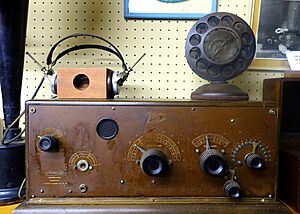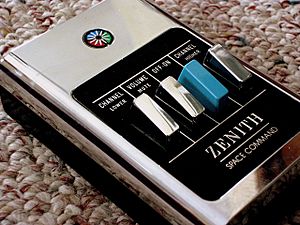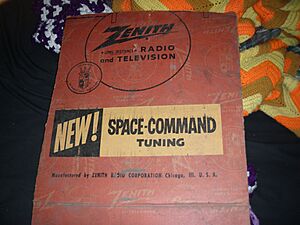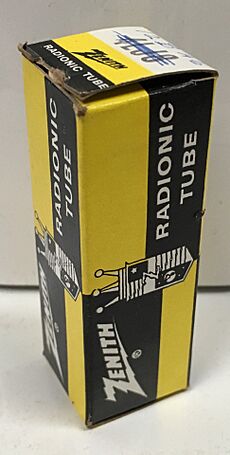Zenith Electronics facts for kids
 |
|

Headquarters in Glenview, Illinois from 1976 to 1999 (demolished in 2018)
|
|
|
Formerly
|
Chicago Radio Labs (1918–1923) Zenith Radio Company (1923–1984) Zenith Electronics Corporation (1984–1999) Zenith Electronics, LLC (1999–present) |
|---|---|
| Subsidiary | |
| Traded as | NYSE: ZN (no longer traded since 1999 due to LG acquisition) |
| Industry |
|
| Founded | 1918 (as Chicago Radio Labs) Chicago, Illinois, U.S. |
| Founders |
|
| Headquarters |
Lincolnshire, Illinois
,
U.S.
|
|
Key people
|
David Penski (CEO) |
| Services |
|
| Revenue | |
|
Number of employees
|
976 |
| Parent | LG Electronics (1999–present) Toyota |
Zenith Electronics, LLC is an American company that focuses on research and development. They create important technologies like ATSC standards for digital TV and digital rights management. This company is currently owned by LG Electronics, a big company from South Korea.
Zenith used to be a famous American brand that made electronics like radios and televisions. Their main office was in Glenview, Illinois, for many years. Zenith was known for its slogan, "The quality goes in before the name goes on." LG Electronics first bought a large part of Zenith in 1995. By 1999, Zenith became a fully owned part of LG. Zenith is famous for inventing subscription television, the modern remote control, and for being the first to develop high-definition television (HDTV) in North America.
Zenith products were sold in many countries, including North America, Germany, India, and parts of Southeast Asia.
Contents
History of Zenith
Zenith started in Chicago, Illinois, in 1918. It was first called Chicago Radio Labs and was founded by Ralph Matthews and Karl Hassel. They made equipment for amateur radio fans. The name "Zenith" came from "ZN'th," which was a short way of saying their ham radio call sign, 9ZN. In 1921, Eugene F. McDonald joined them, and the company officially became Zenith Radio Company in 1923.
This new company quickly became known for making high-quality radios and for its new ideas. Zenith created the first portable radio in 1924. They also made the first radio that ran on regular house electricity (AC radio) in 1926. In 1927, they added easy push-button tuning to their radios. In the 1930s, Zenith started making radios for cars. The first Zenith television set appeared in 1939, and they started selling TVs to the public in 1948. Zenith is also known for inventing the wireless remote control and FM multiplex stereo.
In 1940, Zenith opened one of the first FM radio stations in the country, WWZR in Chicago. This station was also one of the first to broadcast in stereo in 1961.

Zenith helped create better picture tubes for TVs that had higher contrast and flatter screens. They also developed the multichannel television sound (MTS) stereo system used for analog TV in the U.S. and Canada. Zenith was one of the first companies to introduce a digital HDTV system. Parts of their system were used in the ATSC standard for high-definition television. They were also one of the first American companies to sell home VCRs, starting with a Sony-made Betamax recorder in 1977.
By 1960, Zenith was one of the two biggest TV makers in the U.S., along with RCA. They each had more than 20% of the market. Zenith had many employees in its Chicago factories. One of its important parts was the Rauland Corporation, which made TV picture tubes.
In the 1970s, Zenith faced tough competition from Japanese electronics companies. Zenith and other U.S. companies like Sears, Roebuck and Co. and Motorola, Inc., filed a lawsuit against Japanese TV makers. This lawsuit lasted for many years and cost Zenith a lot of money. In 1986, the Supreme Court of the United States decided against Zenith in the main part of the case.
In 1979, Zenith bought Heath Company and started making computers under the name Zenith Data Systems (ZDS). In 1984, the company changed its name to Zenith Electronics Corporation to show it was involved in more than just radios. ZDS became very successful and helped support the rest of Zenith.
By 1988, Zenith was the last American company still making televisions. To get money for new HDTV research and to pay off debts, Zenith sold ZDS in 1989. In 1990, Zenith was having financial problems. To avoid being taken over by another company, Zenith sold a small part of its company to the Korean company GoldStar, which is now LG Electronics.
In 1995, LG bought more of Zenith, taking control of the company. Zenith was too small to compete globally in the electronics world. In 1999, Zenith filed for bankruptcy. LG then bought the rest of the company, turning Zenith's debts into ownership shares. This made Zenith a full part of LG.
After this, some Zenith products were sold under other names like Admiral and Allegro. Zenith's successful Network Systems division, which made set-top boxes for cable and satellite TV, was sold to Motorola in 2000.
Notable Products and Innovations
Shortwave Radio
Some of Zenith's early popular products included the "Royal" series of small transistor radios. They also made the "Trans-Oceanic" series of portable radios that could pick up shortwave broadcasts from far away. These were made from 1942 to 1981.
Subscription Television
Zenith was the first company to try out subscription television with its Phonevision system. This system used a special box connected to the TV and a phone line. Viewers would call an operator to unscramble a movie broadcast. Even though the movies were old, most people who tried Phonevision said they would prefer to watch films at home.
Remote Controls
Zenith is perhaps most famous for creating the first useful wireless television remote control, called the Space Command, in 1956.
The very first TV remote control, made in 1950, had a wire. People didn't like the wire running across their living rooms. Zenith's president, Eugene F. McDonald, asked his engineers to make a wireless one. The first wireless remote, the 1955 Flash-Matic, used a light beam. But bright sunlight could accidentally change the channels!
Then, engineer Robert Adler suggested using ultrasonic sound waves. The remote control had small aluminum rods that made different high-pitched sounds when you pressed a button. The TV would hear these sounds and change channels or volume. Because pressing the buttons made a "click" sound, people started calling remote controls "clickers." This ultrasonic technology was used until the 1980s when it was replaced by infrared light.
Zenith said that the Space Command remote helped increase TV sales by 40%. The company allowed other companies like RCA to use their technology. The Space Command 600, introduced in 1965, was designed for color TVs and could even adjust color hues.
Space Phone
Some Zenith System 3 televisions from the late 1970s to early 1990s had a special feature called the Space Phone. This was like a hands-free speakerphone built right into the TV. You could connect the TV to a phone jack. Then, using the TV's remote control and a built-in microphone, you could dial numbers and talk to someone on the phone, with the sound coming through the TV's speakers.
The Porthole Television
When Zenith started making televisions in the late 1940s, they had a unique design. These TVs had a round screen, and the entire round screen was visible, like a porthole on a ship. They came in different sizes. Later models even had a switch to show the picture in the standard 4:3 ratio or to fill the whole round screen. These "porthole" TVs are very popular with collectors today.
Hand-Wired Chassis
In the 1950s, many electronics companies started using printed circuit boards in their radios and TVs. But Zenith continued to use a method called "hand-wired chassis" for its vacuum tube equipment. This meant that the parts were connected by hand with wires, rather than being soldered onto a circuit board. This was important because vacuum tubes get very hot, and the heat could damage circuit boards over time. Zenith believed that hand-wired construction made their products more durable. Because of this high-quality building method, many Zenith TVs and radios from the 1950s to 1970s still work well today.
See also
 In Spanish: Zenith Electronics para niños
In Spanish: Zenith Electronics para niños
- Zenith (disambiguation)








